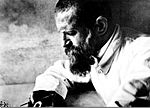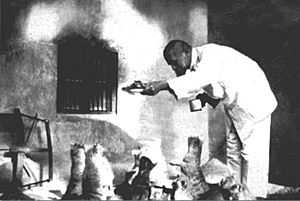Robert Koldewey facts for kids
Quick facts for kids
Robert Koldewey
|
|
|---|---|

Robert Koldewey
|
|
| Born | 10 September 1855 Blankenburg am Harz, Duchy of Brunswick, German Confederation
|
| Died | February 4, 1925 (aged 69) |
| Nationality | German |
| Known for | Babylonian Excavations |
| Scientific career | |
| Fields | archaeologist, |
Robert Johann Koldewey (born September 10, 1855 – died February 4, 1925) was a German archaeologist. He became famous for digging up the ancient city of Babylon. This city is in modern-day Iraq.
Koldewey was born in Blankenburg am Harz, Germany. He passed away in Berlin when he was 69 years old.
His excavations at Babylon uncovered important structures. These included the base of the ziggurat of Marduk and the famous Ishtar Gate. He also created new ways to find and dig up buildings made from mud brick. This method was very helpful. He used it when looking for the Hanging Gardens of Babylon. These gardens were thought to be built around 580 BC.
Robert Koldewey worked as an archaeologist for most of his life. He led many digs in places like Asia Minor, Greece, and Italy. After he died, a group called the Koldewey Society was formed. It was created to remember his work in architecture and archaeology.
Contents
Early Life and Learning
Robert Koldewey went to school in Braunschweig. In 1869, his family moved to Altona. There, he attended the Christianeum school. He finished his studies there in 1875.
Koldewey taught himself a lot about ancient history and archaeology. He studied architecture and art history in Berlin and Vienna. However, he did not finish a degree at either university. In 1882, he joined a dig in ancient Assus in Turkey. This is where Koldewey learned many important digging methods. He also learned how to draw ancient ruins accurately.
Exploring Ancient Sites
Francis H. Bacon, an American archaeologist, introduced Koldewey to archaeology. This happened at the Assos excavation in 1882–1883. Koldewey then worked for the German Archaeological Institute. He led digs at Greek sites like Lesbos (1885–1886). He also explored sites in Mesopotamia, such as Lagash (1887). From 1890 to 1891 and again in 1894, he worked with Felix von Luschan. They excavated an ancient Greek city in Sicily.
Digging Up Babylon
With help from the Deutsche Orient-Gesellschaft (German Oriental Society), Koldewey directed the excavation of Babylon. This project lasted from 1899 to 1914. He used new and modern archaeological methods for his time. The site of Babylon had been identified about a hundred years earlier.
More than 200 people worked every day, all year round, for fifteen years. In 1899, Koldewey's team uncovered Babylon's main Processional Street. This was the first time the modern world saw parts of this famous ancient city. The expedition also found the outer walls, inner walls, and the foundation of Etemenanki. This temple is sometimes thought to be the "Tower of Babel". They also dug up the palaces of King Nebuchadnezzar.
Walter Andrae, who was part of the expedition, later made models of Babylon. These models are now in the Vorderasiatisches Museum Berlin. The excavations at Babylon were very important for Germany. They received good funding and were widely talked about.
The Hanging Gardens Mystery
The Hanging Gardens of Babylon were a famous legend. They were described as a beautiful man-made mountain covered in plants and trees. Stories said King Nebuchadnezzar (who ruled from 605 BC to 563 BC) built them. He supposedly built them for his wife, Amytis, who missed her home.
While digging in the Southern Citadel, Robert Koldewey found a basement. It had fourteen large rooms with stone arch ceilings. Ancient writings showed that only two places in Babylon used stone. One was the north wall of the Northern Citadel, which had already been found. The other was the Hanging Gardens. This made Koldewey believe he had found the cellar of the gardens.
He kept exploring the area. He found many features that the ancient Greek historian Diodorus had described. Koldewey was sure he had found the gardens. However, some modern archaeologists have questioned his discovery. They agree that Koldewey's dig site was where Babylon was located. But they argue that the site was too far from the Euphrates River. It would have been hard to get enough water there for a large green garden. Also, another ancient Greek historian, Strabo, said the Hanging Gardens were right next to the river. The arched rooms Koldewey found were most likely a storeroom. Later, cuneiform tablets with lists of supplies were found in the ruins.
See also
 In Spanish: Robert Koldewey para niños
In Spanish: Robert Koldewey para niños
- Biblical archaeology
- List of artifacts significant to the Bible


